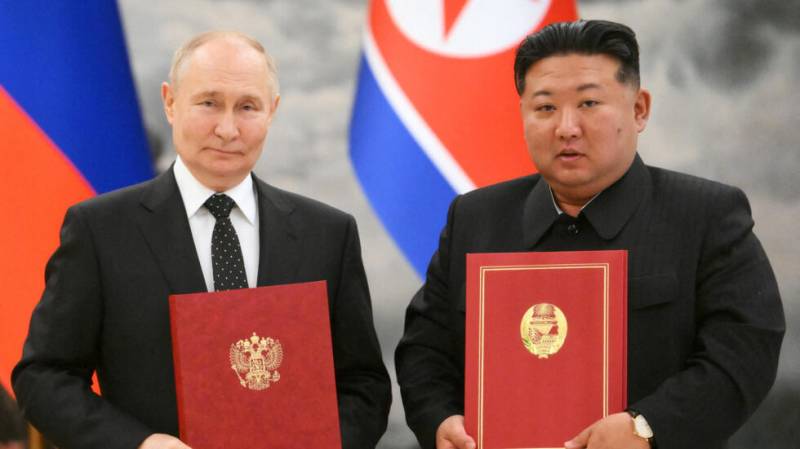
Why did Putin visit North Korea?
Russian President Vladimir Putin visited North Korea on a two-day state visit on June 19 – the first in 24 years. Putin had last visited in 2000, when Kim Jong Il, Kim Jong Un’s father, was the leader of North Korea, and Putin was only recently elected as President.
In this week’s state visit, Kim Jong Un and Putin announced a defense pact between the two countries that would provide “mutual assistance in the event of aggression.” The Russian media reported the pact as a ‘Comprehensive Strategic Partnership’ agreement.
Kim Jong Un also promised full support for Russia’s war in Ukraine, as relations between the two countries have gotten stronger in what Kim labelled as a fight against the “hegemonic and imperialist policies of the United States.”
North Korean state-owned news agency KCNA described North Korea and Russia’s relations “as a strong strategic fortress for preserving international justice, peace and security and an engine for accelerating the building of a new multi-polar world.”
The reasons for Putin’s visit to North Korea are simple: Putin needs arms and ammunitions for the war effort in Ukraine, and North Korea produces the high caliber artillery shells that Russia needs to keep the war going. Putin is using his need for North Korean weapons as an opportunity to send a threatening message to the West: that continued support for Ukraine will intensify security threats that may have fallen to the backburner after the war in Ukraine became the center of attention.
Does Russia really need North Korea’s help?
North Korea has emerged as a major arms manufacturer, and has only recently provided as many as five million rounds of ammunition, including artillery shells, to support Russia’s war in Ukraine. Reports from the US State Department suggest that North Korea may have provided as many as 11,000 shipping containers of arms and ammunitions to Russia in recent months.
Putin needs the ammunition from North Korea to sustain the Russian war machine in Ukraine. Increased collaboration with North Korea also helps Russia undermine the legitimacy of Western sanctions, and Putin likely wants to use the opportunity to provide Pyongyang with material support to make North Korea a more concerning threat in Western capitals.
Reports suggest North Korea is providing Russia with weaponry in exchange for technological expertise. Putin will likely offer Kim further assistance and expertise, which could help North Korea design a nuclear warhead that could survive re-entry into the planet’s atmosphere and give its ballistic missiles true intercontinental range, and the ability to strike targets in the United States. Kim Jong Un’s wishlist also likely includes stealth submarines and the technology needed to evade ballistic missile defenses.
North Korea has been under stringent UN sanctions for years due to its nuclear and missile programs. Together with China, North Korea's main ally, Russia has consistently blocked US-led attempts to impose new UN sanctions on North Korea.
In March, Russia vetoed the continuation of UN sanctions monitoring, leaving US and South Korean officials scrambling to explore new ways to monitor Pyongyang's activities.
Does Putin’s visit signal a new strategic partnership?
Even though the former Soviet Union was one of North Korea’s staunchest allies, the recent deepening of ties between Putin’s Russia and Kim Jong Un’s North Korea are better understood as a marriage of convenience, and the result of a transactional and opportunistic relationship.
It remains entirely unclear if this state visit heralds the formation of a deeper strategic partnership between the two states.
Why is Putin visiting Vietnam after North Korea?
After concluding his state visit in North Korea, Putin flew from Pyongyang to the Vietnamese city of Hanoi.
Vietnam is ruled by a communist party that has a stated foreign policy of being friends with everyone and avoiding all formal alliances. The former Soviet Union also provided Vietnam with support during the course of the twentieth century, with many Vietnamese also knowing the language and having studied in Russia during the Cold War.
Observers suggest that Putin’s decision to visit Vietnam is aimed at demonstrating to the West that despite Russia being targeted by Western sanctions, it remains a power player on the geopolitical chess board.
Vietnam, despite being a rising economy in Asia and a key commercial partner for American firms in the textile and technology industries, has maintained a neutral stance on Russia’s war in Ukraine.
Due to the legacy of the Cold War relations, Russia is still Vietnam’s largest weapons supplier, and military ties are likely to be an important topic of conversation between Putin and President To Lam.
Vietnam’s foreign policy is often described as “bamboo diplomacy,” a metaphor for the bamboo plant’s flexibility to bend without snapping.
How has the US reacted to Putin’s visit?
Predictably, the United States has not taken well to Putin’s visit to Vietnam.
“No country should give Putin a platform to promote his war of aggression and otherwise allow him to normalize his atrocities. If he is able to travel freely, it could normalize Russia’s blatant violations of international law,” a US embassy spokesperson in Hanoi told Reuters.

